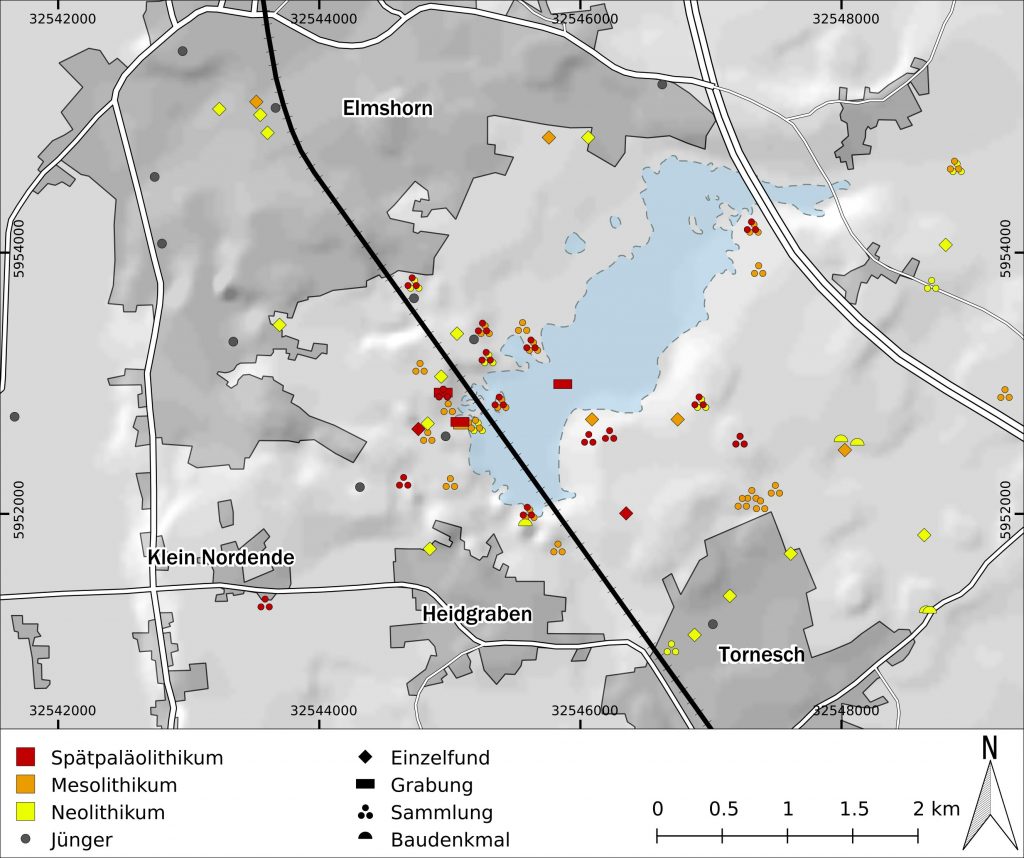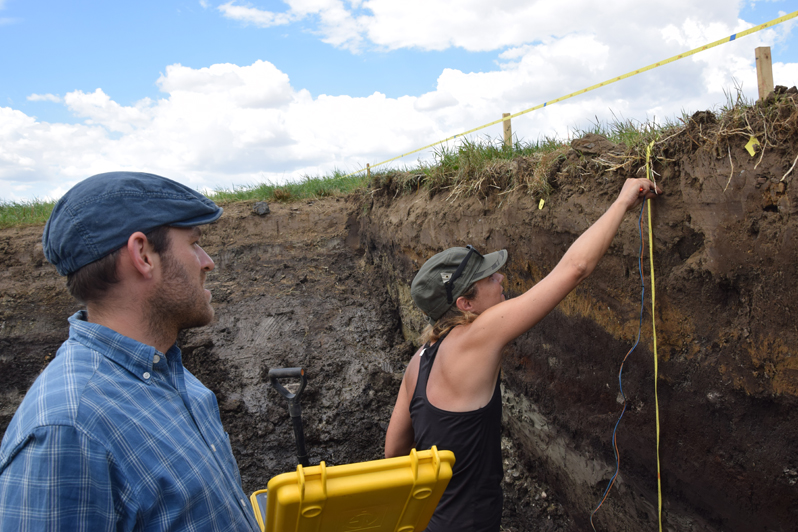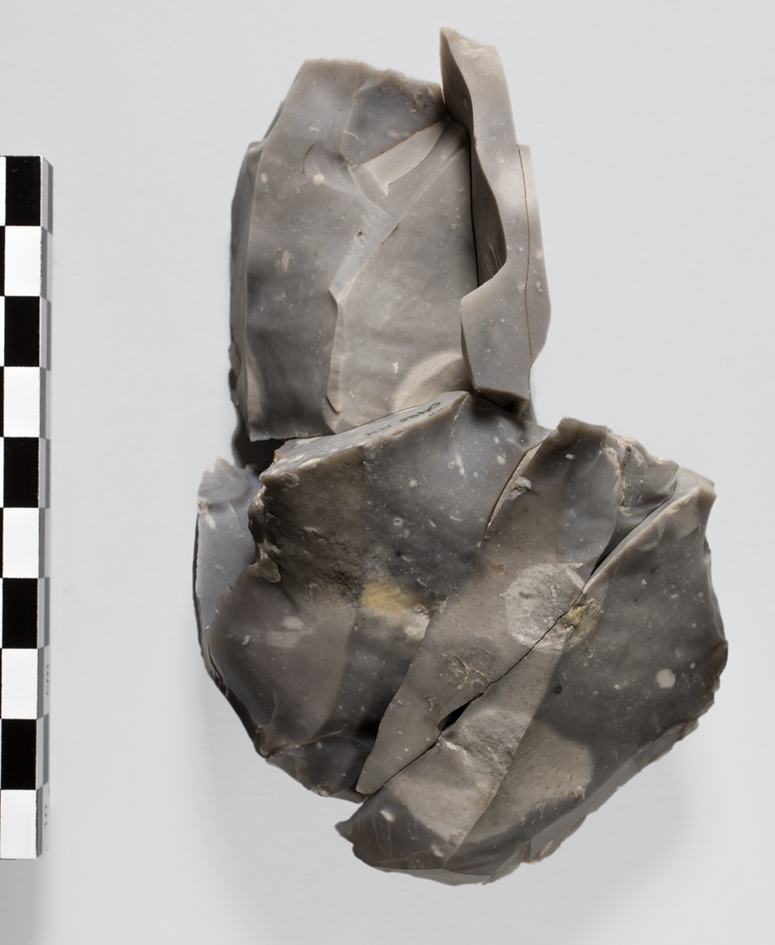What we learned in 2018
Research activities of the CRC 1266 project B1 „Pioneers of the North“
In 2018 we continued research in several of our work packages (WP) to relate our results from our study areas in the south-western Baltic region to the socio-environmental transformations during the Late Pleistocene (re-)colonisation process of Northern Europe. The meanwhile six main archaeological areas (Ahrensburg Tunnel Valley, Lieth Moor, Lake Itzstedt, Alt Duvenstedt, Ahrenshöft, Horsens) and a database of Palaeolithic and Mesolithic sites in Schleswig-Holstein (Palaeodatabase) provided further evidence to qualify the four previously identified transformation periods (T1-4).
Therefore, we engage in on-going discussions about how to understand pioneers and transformation, but also about the Lateglacial nomenclature that will be incorporated in many of our publications and help making them concise.
WP1 (Ahrensburg Tunnel valley): Based on Early Holocene radiocarbon results of sub-project B2 from the Borneck site, we decided to review the Ahrensburgian material from this site using a spatial and technological approach. This resulted in a M.A. thesis (Moiken Hinrichs) that has been submitted in April 2019.
WP2 (Lieth Moor area): We created different distribution maps of the Final Palaeolithic sites in this area (figure below) to help us understand the development in this area. The review of some of the archaeological material attributed to the Federmesser-Gruppen (FMG) has formed part of a M.A. thesis that has been submitted in February 2019 (Tobias Burau).

WP3 (Palaeodatabase) This WP has taken more time than originally intended as the database needed to be intensively reviewed (see WP 7). This delayed the collaboration with A2 on the distribution of archaeological sites and predictive modelling towards the end of the year. However, the collaboration was further expanded towards testing the usability of the Final Palaeolithic record in a concept of cultural distance as a marker for interaction. As the predictive models were not yet available, we examined several sites that we were made aware of by colleagues or by our previous results, and we evaluated them regarding their palaeoenvironmental and archaeological potential. The former was mostly a disqualifying parameter. We also revisited archaeological material from museums’ collections that will help reviewing the Palaeodatabase. In this context, we also had many fruitful discussions and meetings with MfA staff to clarify possibilities to submit information to the archaeological (find) database of Schleswig-Holstein (ADSH).
WP4 (Itzstedt Lake area) Sascha Krüger’s palynological analysis of the sediment core taken in this study area last year is still on-going. Besides some interesting peaks in the charcoal content, he also could already identify two tephra layers in the Early Holocene and the Dryas 3 part. Jan Weber (E1) used the twin core to conduct XRF-scans and retrieve samples for geochemical analyses, in particular searching for wax lipids. The results of the latter analysis are going to be compared to the palynological results to test how much they are in agreement and to increase our understanding of the Late Pleistocene vegetation development by this combination of analytical techniques. In collaboration with G1 we also could date some macro-plant material that will help building an age-depth model for this sequence. Preliminary results were presented at the Lunch Time Seminar series in winter term 2018/19. Further details about the archaeological material from the nearby sites were collected from ALSH reports.
WP5 (Alt Duvenstedt) The oldest Federmesser-Gruppen material was analysed in collaboration with a colleague from the CNRS in Nanterre.
WP6 (Ahrenshöft) The find database of this site was supplemented with the finds from sieving and was made ready to be analysed using GIS-methods. Further technological analyses of the lithic material contributed in comparison with later periods to the M.A. thesis of Tobias Burau.
WP7 (Synthesis) An article synthesising our current knowledge about the Ahrensburgian in the south-western Baltic area is in preparation. Therefore, we collected all sites of this technocomplex known thus far from Hamburg, Schleswig-Holstein, and Denmark. Preliminary maps showed that there might be some falsely labelled assemblages in the Palaeodatabase / ALSH database. Consequently, we met with Sönke Hartz (MfA) and Ingo Clausen (ALSH) to discuss all questionable Ahrensburgian assemblages. During this meeting, the necessity of further meetings about the other technocomplexes in the near future became evident.
Looking in more detail at some areas already indicated that the distribution of sites cannot be explained randomly and that in particular Ahrensburgian sites are placed relatively even across the Schleswig-Holstein. In contrast, the Lieth Moor area, but also the Ahrensburg Tunnel Valley data, suggest that the Federmesser-Gruppen sites are placed at different locations suggesting a significant change in the use of the environment between those two groups. Yet, this impression needs to be tested by data comparisons and geostatistics. One approach is in collaboration with A2 on this. Provided with the geographic and chronological information about sites by us, Daniel Knitter and Wolfgang Hamer (both A2) could begin to model the human settlement in Schleswig-Holstein and Denmark in our periods of interest. First results showed that we have to further refine our approaches if we wish this comparison of the results to the today known landscape to be meaningful. This is mainly due to the very scarce distribution of our record in space and time.
WP8 (Horsens area) Further surveys in Tyrsted and Gedved were made with our collaboration partners from the Horsens Museum, the National Museum of Denmark and the geophysics sub-project G2 (figure below). Palaeoenvironmental and archaeological analyses on material from the Tyrsted are on-going. Sub-project F4 conducted a molecular biological analysis of the reindeer material from this site and Berit V. Eriksen will analyse the lithic material from this context.

What we have learned about our transformation phases thus far:
T1 (classic Hamburgian-Havelte Group) This transformation represents the first appearance of humans after the Last Glacial Maximum and their pioneer movement into the south-western Baltic region. Here we could particularly add some palaeoenvironmental work. Sascha Krüger has submitted his first manuscript about the sequence from Lake Bølling trying to clarify the nomenclature and characteristics of this earliest part of the Lateglacial Interstadial in this region. Furthermore, this period is also present in the sediment sequence from the Lake Itzstedt region where Hamburgian archaeological material was also found nearby the coring site. This combination makes a detailed search for a human signal worthwhile.
T2 (Havelte Group-Federmesser-Gruppen-Brommean?) This period reflects a first diversity in the record for which different hypotheses exist. A technological comparison of Havelte Group and Federmesser-Gruppen lithic material resulted in a M.A thesis (Tobias Burau). There the author argued that this process might be no transformation at all but rather a replacement as no transition between the two concepts was visible. Furthermore, the available radiocarbon dates for the studied assemblages indicated an almost co-existence of the different technological concepts. The question arising from this result concerns the relationship of the different technocomplexes with different environmental settings. Here the previously collected information from the legacy of Hartmut Usinger will make further clarifications possible.
T3 (Federmesser-Gruppen-Brommean-Ahrensburgian) This period reflects a second period of strong diversification in the archaeological record of the south-western Baltic. Again the research question concerns the influence of environments that are in the state of changing. Preliminary results from analysing an early Ahrensburgian assemblage in comparison with differently dated Federmesser-Gruppen inventories point out a possible techno-economic development that was previously disregarded. However, what this observation means and how valid it is remains to be tested in more detailed analyses. Also our work on the material from the Horsens region will help to further identify and contextualise the changes in this period.
T4 (Ahrensburgian-Early Mesolithic) Per recommendation of the initial DFG evaluation we have put more focus on the final transformation period that forms a bridge to the sub-project B2, and so we have collaborated with this sub-project on several occasions. In particular, we developed a flint registration system in close collaboration that will allow quantitative but also to some degree qualitative comparisons of the different inventories in the future. Two Ahrensburgian inventories from a site where Mesolithic material was found nearby (see WP1) are already analysed using this system. Besides this typo-technological registration of the material, refitting of the artefacts was carried out to also understand the spatial organisation of this site. The results have just been submitted in a M.A. thesis (Moiken Hinrichs). We also submitted an article on the timing and environmental context of this transformation in northern Germany together with B2. The development of the environment during this period will also be further informed by the sediment core from the Lake Itzstedt region that will be correlated across this period with the Poggensee sequence (F2). In our additional collaboration with A2, we will also focus on this transformation period and already discussed a possible expansion of our general collaboration on site distributions from the Mesolithic. In 2019, the thus far known changes as well as continuities across this period will be assembled in a joint EAA presentation and will help us to further examine this important transformation.

In 2018 our team included:
PD Dr. habil. Berit V. Eriksen (PI),
Dr. Sonja B. Grimm (Post-Doc),
Sascha Krüger M.A. (PhD-student),
Dr. Mara-Julia Weber (ZBSA),
Katja Winkler M.A./Dr. des. (research assistant then research associate),
Benjamin Serbe M.A. (research assistant),
Tobias Burau B.Sc. (student assistant),
Moiken Hinrichs B.A. (student assistant).